5 Spooky (Insider) Facts About The Glore Psychiatric Museum

If you grow up in a town with something weird or noteworthy, you sort of become desensitized to it. It's just a normal thing that you pass by every day. In Saint Joseph, Missouri, that place is the Glore Psychiatric Museum, a morbid trip through the brutal treatment of mental illness through history. It's the sort of place that draws curious visitors from far outside the town and occasionally gets national attention for just how out there it is -- a site that deserves its time in the spotlight. It's eerie, bizarre, and possibly even haunted.
Oh yeah, and I spent a summer working there, so I know all about it ...
From Hospital To Museum
Don't Miss
Let's table the discussion of ghosts for a second because honestly, the definite eeriness of the Glore Psychiatric Museum deserves just as much credit as the spirits that may or may not reside there. Glore is housed in a real insane asylum, or part of it anyway. The museum is located in what used to be the surgical building of the State Lunatic Asylum #2, which opened in 1874 and sounds like a location that should be in the new Resident Evil game. The campus of the asylum was large and almost entirely self-sufficient. As forms of occupational therapy, patients at the hospital grew crops and did other activities that kept the hospital running for more than a century.
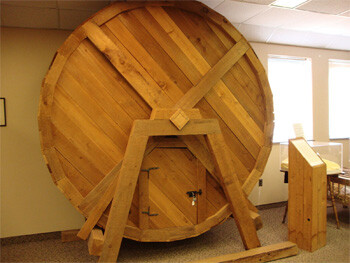
In the 1960s, George Glore entered the picture. Glore was a longtime mental health professional, and in 1968, he and patients at the hospital constructed what would become the first exhibits in the museum. It might have looked like he was constructing torture devices because that's basically what he was doing. Glore wanted to increase awareness for how poorly the mentally ill were treated, even in that very hospital, and did so by creating reproductions of horrific inventions that asylums used to "treat" patients. This includes the "Bath of Surprise," a tub that patients were unexpectedly dropped into -- the shock of the water was supposed to calm them down.
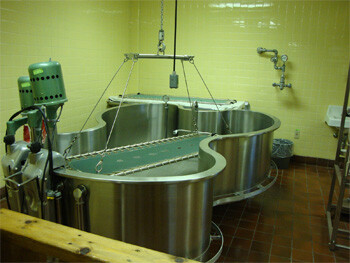
After these exhibits were finished, they were put on display for the public for Mental Health Awareness Week, and they were a big hit. Some people were fascinated to learn about just how inhumane old hospitals were; others just thought the macabre stuff was cool. Either way, the success of the exhibits led to the formation of a permanent museum for them. Then there was a whole transition in the way that mental illness was treated that led to the old asylum growing obsolete. In the end, most of the buildings that made up the asylum campus were turned into a prison, except the old surgical building, which became the permanent home of the Glore Psychiatric Museum.
Yes, the museum is scenically located next to a prison.
Is It Haunted?
All right, now let's get to the question that everyone wants to know: Is the museum haunted?
Initially, publicity for the museum came from the brutal reproductions that George Glore made, but as it settled down in its location and visitors regularly came by, the museum earned itself a new reputation. According to many, the museum was haunted by the ghosts of the asylum's tortured patients. During my time at the museum, I heard all sorts of stories from other museum employees, volunteers, and visitors. Some said that they heard screaming in one place or another. Others felt unexplained bursts of cold air as they walked through the old hospital. Regularly, ghost hunters make their way to the museum, either because they heard from other paranormal folks that it's a lively place or because the museum hosted a ghost event.
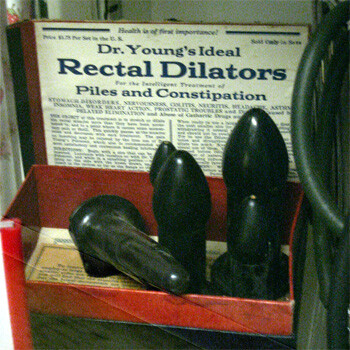
Now, did I ever have my own paranormal encounter? Was I in contact with a specter? Well, on my very first day there actually, I was walking through the halls of the museum alone when I heard the distant voice of a child. "Mommy!" the voice called. A chill sent through my spine. The stories were real. The voice got closer. And closer. Then ... I saw that it was a kid and their mom down the long hallway of the museum, and their voice had been echoing.
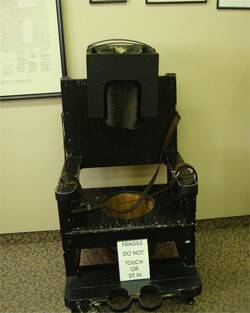
Yeah, sorry to burst any bubbles, but I can't say that I ever saw anything too unexplainable. The threat of such a thing happening is part of the appeal, though (even for skeptics). No matter how many times I went through the museum, there was still a feeling of tension, like at any moment a door could slam shut or a figure could appear in a mirror.
You Don't Need Ghosts To Be Spooky
The ever-present threat of a ghost sighting might be what used to bring people through the door, but what really keeps the Glore Psychiatric Museum popular is the morbidly interesting collection in the old asylum. What began with the replicas designed by George Glore evolved into one of the most unique collections of artifacts and stories that a museum has to offer.
Outside of Glore's reproductions, there is a lot of stuff at the museum that is real, things left behind by patients. Thousands of empty cigarette packs are kept in a cage because a patient was told by a nurse that if they saved up enough, they could redeem them for a new wheelchair (thankfully, the staff did buy him one for his efforts). There's also an old TV is filled with written notes that a patient stuffed inside because they believed they could communicate with the people on TV. (This was decades before Twitter allowed unstable fans to actually do that.)
And most famously, there is the stomach contents exhibit. A patient had swallowed hundreds of nails and other objects and then died because that's what happens when you swallow hundreds of nails. All of the contents were removed from her stomach, and someone then decided that the logical thing to do would be to artistically arrange them so that they look like an ancient sculpture of a bursting sun. Now the stomach contents are one of the main focal points of the museum; at least once a day, I saw someone buy a postcard with the exhibit pictured on it.
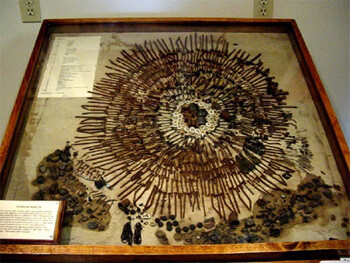
Together, each of these exhibits tells a story that doesn't require ghosts to be scary. It's a story of how society did not understand mental illness to a dangerous degree, and it says that even though we've come far, there is still room to improve. And it's a story that wrote itself. Each hallway of the Glore Museum feels like it could be part of the hotel in The Shining. But it isn't. It is a real location where real people with real problems were trapped.
And Then There's The Basement
Okay, for the most uncomfortable experience at the museum, look no further than the basement, which was quite literally designed for an apocalyptic event. Because the building that houses the Glore Museum was the campus's surgical building, the rest of the museum feels like a hospital. The rooms and hallways have a design that clearly resembles a traditional hospital, even if new doors and other features have been added to make the building flow more like a museum. Though the basement does have jarring reminders that, oh yeah, this place is legit. The most striking of these is the hospital morgue.
Yes, because the hospital was created to be mostly self-sufficient, that included having an on-site morgue. Patients who died at the hospital were then buried on hospital grounds in an area that is now operated by the prison. This creates a sort of weird existential dread as a museum visitor. Some patients were completely forgotten about once they entered the hospital doors. They lived there, died there, and were buried there. It's haunting, and not just because of the ghosts.
This feeling is made even more real because the freezers in the morgue are still kept cool. This may seem like it's done for show, a way to keep up the mystique of the museum, and in a way, it might be. It was a draw, too; at least twice a week, I would have to tell someone that they couldn't climb into the morgue. I guess they thought it'd be a good photo op. In practice, the freezers are kept cool in the chance that every other morgue in town is full. It has never, to my knowledge or research, happened, but if any worst-case scenario ever came true, there could be coroners rushing into the Glore Psychiatric Museum with a corpse to freeze.
Images of upcoming dread are made even more prevalent because the basement is a designated fallout shelter. Step down into the basement, and you'll be greeted by signage to remind you that the Glore Museum basement could survive a nuclear blast. So that's comforting, I guess. It all comes together to make the basement feel like it should be a haunted house, the sort where a cast member would rise out of the morgue and make creepy sounds. But nope. This is just a real location.
It's Not All Doom And Gloom
While the museum has a lot to say about a dark subject, there is a sort of comfort in it all too. Artifacts that demonstrate patient mistreatment sit near displays of patients' artwork that attempt to explain to the misunderstanding public how they were feeling. The same basement that feels like a set in a post-apocalyptic movie also contains classic cars that had been painted and decorated by young patients at the hospital. The cars were taken to car shows and won major prizes.
I guess what I'm saying is that when I walked through the museum, I never just felt creeped out or anything. Yeah, there is a perpetual eeriness to it all, but at some point, I just accepted going down the rabbit hole. As I got deeper, the sights got stranger, but I also grew to understand it more.

Day 101: That's some pretty neat embroidery, actually.
This is what I saw with a lot of museum visitors too. They would come in thinking they would find ghosts or see the crazy things that people used to do. When it was time for them to leave, though, it was like something had grown in them. They came to understand the differences in people and to not brush everything that diverts from their norms as "crazy." And before they left, they always made sure to drop a quarter to take home a stomach contents postcard. I like to think it left a positive impression on them.